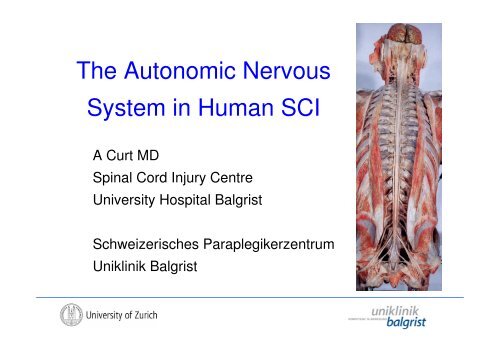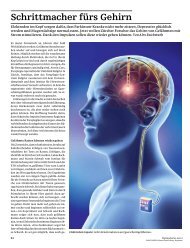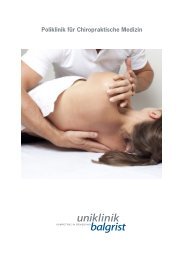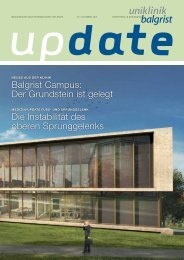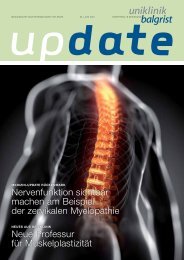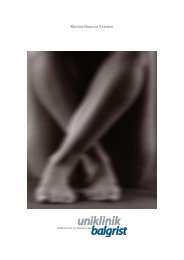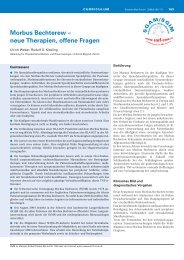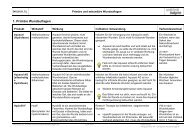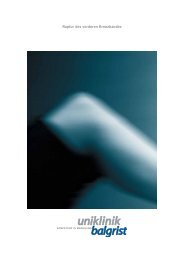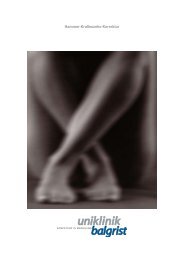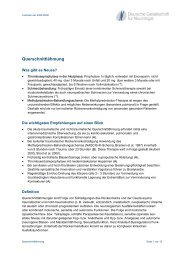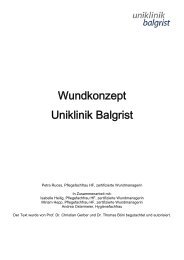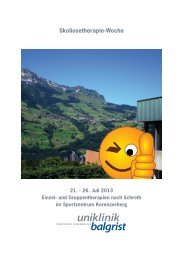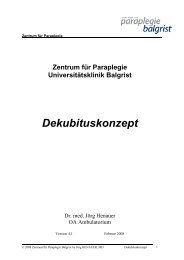The Autonomic Nervous System in Human SCI - Uniklinik Balgrist
The Autonomic Nervous System in Human SCI - Uniklinik Balgrist
The Autonomic Nervous System in Human SCI - Uniklinik Balgrist
You also want an ePaper? Increase the reach of your titles
YUMPU automatically turns print PDFs into web optimized ePapers that Google loves.
<strong>The</strong> <strong>Autonomic</strong> <strong>Nervous</strong><br />
<strong>System</strong> <strong>in</strong> <strong>Human</strong> <strong>SCI</strong><br />
A Curt MD<br />
Sp<strong>in</strong>al Cord Injury Centre<br />
University Hospital <strong>Balgrist</strong><br />
Schweizerisches Paraplegikerzentrum<br />
Unikl<strong>in</strong>ik <strong>Balgrist</strong>
<strong>Autonomic</strong> <strong>Nervous</strong> <strong>System</strong><br />
John Newport Langley <strong>in</strong>troduced the term<br />
“<strong>Autonomic</strong> <strong>Nervous</strong> <strong>System</strong>” <strong>in</strong> 1898<br />
he was a lecturer from 1883 to 1903 and Professor of Physiology<br />
from 1903 to 1925 at the University of Cambridge
<strong>Autonomic</strong> <strong>Nervous</strong> <strong>System</strong><br />
John Newport Langley <strong>in</strong>troduced the term<br />
“<strong>Autonomic</strong> <strong>Nervous</strong> <strong>System</strong>” <strong>in</strong> 1898<br />
he was a lecturer from 1883 to 1903 and Professor of Physiology<br />
from 1903 to 1925 at the University of Cambridge<br />
• Langley, John Newport. 1921. <strong>The</strong> <strong>Autonomic</strong> <strong>Nervous</strong> <strong>System</strong>. Cambridge<br />
• Langley, John Newport. 1898-1900. <strong>The</strong> Salivary Glands. In: Text-Book of<br />
Physiology, edited by E. A. Schäfer, Ed<strong>in</strong>burgh, London<br />
• Langley, John Newport and Charles S. Sherr<strong>in</strong>gton. 1891. On Pilomotor Nerves.<br />
Journal of Physiology 12: 278-291<br />
• Langley, John Newport. 1898-1900. <strong>The</strong> Sympathetic and Other Related <strong>System</strong>s of<br />
Nerves. In: Text-Book of Physiology, 616-696. Ed<strong>in</strong>burgh, London: E. A. Schäfer
What is special?<br />
• Old part of the CNS<br />
• No voluntary control<br />
• No immediate dist<strong>in</strong>ct feedback<br />
• Equilibrium system<br />
– Balanc<strong>in</strong>g outputs (cardio-vascular system..)<br />
– Indirect control and responses<br />
– Hierarchical organization<br />
• Specific anatomical organization
<strong>Autonomic</strong> <strong>Nervous</strong> <strong>System</strong><br />
• cardiac pac<strong>in</strong>g<br />
• blood pressure<br />
• temperature<br />
• sweat<strong>in</strong>g<br />
• bladder<br />
• bowel<br />
• sexual
Sp<strong>in</strong>al Cord Injury<br />
Special model of autonomic dys-balance
Sp<strong>in</strong>al Cord. 2009 Jan;47(1):36-43<br />
International standards to document rema<strong>in</strong><strong>in</strong>g<br />
autonomic function after sp<strong>in</strong>al cord <strong>in</strong>jury<br />
Alexander MS, Bier<strong>in</strong>g-Sorensen F, Bodner D, Brackett NL, Cardenas D, Charlifue S, Creasey G, Dietz V, Ditunno J, Donovan<br />
W, Elliott SL, Estores I, Graves DE, Green B, Gousse A, Jackson AB, Kennelly M, Karlsson AK, Krassioukov A, Krogh K,<br />
L<strong>in</strong>senmeyer T, Mar<strong>in</strong>o R, Mathias CJ, Perkash I, Sheel AW, Schilero G, Schurch B, Sonksen J, Stiens S, Wecht J, Wuermser<br />
LA, Wyndaele JJ.<br />
Experts op<strong>in</strong>ions consensus<br />
… common strategy to document rema<strong>in</strong><strong>in</strong>g autonomic neurological function follow<strong>in</strong>g <strong>SCI</strong>.<br />
… commissioned by ASIA and ISCoS<br />
RESULTS: Four subgroups were commissioned: bladder, bowel, sexual function and general autonomic<br />
function. ...<br />
http://www.asia-sp<strong>in</strong>al<strong>in</strong>jury.org/publications<br />
/<strong>Autonomic</strong>_Standards_Assessment_Form_FINAL_2009.pdf
Steer<strong>in</strong>g Committee: Marcalee Sipski Alexander, F<strong>in</strong> Bier<strong>in</strong>g-Sorensen, Susan Charlifue,<br />
Volker Dietz, John Ditunno, Dan Graves, Michael Kennelly, Andrei Krassioukov, Ralph<br />
Mar<strong>in</strong>o, Steven Stiens, Lynne Weaver<br />
Urology Doma<strong>in</strong>: Michael Kennelly, Diana Cardenas, Graham Creasey, Angelo Gousse, Bruce Green,<br />
Todd L<strong>in</strong>senmeyer, Brigitte Schurch, Jean-Jacques Wyndaele<br />
Bowel Doma<strong>in</strong>: Steve Stiens, Irene Estores, Klaus Krogh, Inder Perkash<br />
Sexual Function Doma<strong>in</strong>: Marcalee Sipski Alexander, Don Bodner, Nancy Brackett, Stacy Elliott,<br />
Amie Jackson, Jens Sonksen<br />
Cardiovascular, Sudomotor and <strong>The</strong>rmoregulatory Doma<strong>in</strong>: Andrei Krassioukov, Ann-Katr<strong>in</strong><br />
Karlsson, Ralph Mar<strong>in</strong>o, Christopher J. Mathias, Jill Wecht, Lisa Wuermser
Kl<strong>in</strong>ik der autonomen Dysfunktion<br />
urologisch<br />
Inkont<strong>in</strong>enz (urgency/frequency)<br />
Retention<br />
a-hypokontraktiler Detrusor<br />
Detrusorhyperreflexie<br />
Schrumpfblase<br />
Blasen-Nierenste<strong>in</strong>e<br />
Sph<strong>in</strong>kter-Detrusor Dyssynergie<br />
Hydronephrose<br />
vesicorenaler Reflux
Kl<strong>in</strong>ik der autonomen Dysfunktion<br />
sexuell<br />
gastro<strong>in</strong>test<strong>in</strong>al<br />
sudomotorisch<br />
Erektion/Emission/Ejakulation<br />
Fertilität / Orgasmus<br />
Paralytischer Ileus<br />
Obstipation, Diarrhoe<br />
An-/Hypo-/Hyperhydrosis<br />
<strong>The</strong>rmodysregulation<br />
Pupillomotorik<br />
Hornersyndrom
Kl<strong>in</strong>ik der kardio-vaskulären<br />
Dysfunktion<br />
Bradykardie (Asystolie)<br />
(Hypervagotonie)<br />
Sympathetic failure<br />
(Hyposympathonie)<br />
Autonome Dysreflexie<br />
(Dysregulation)<br />
Nocturnale sympathische<br />
Dysregulation<br />
Intensivstation<br />
temp. pacemaker<br />
Mobilisation<br />
Blutdruckkrisen mit<br />
Bradykardie<br />
24 RR-monitor<strong>in</strong>g
Orthostatic hypotension = Sympathetic failure<br />
Sympathetic (orthostatic) failure <strong>in</strong> acute and chronic <strong>SCI</strong><br />
Incompletely rebalanced <strong>in</strong> the chronic stage<br />
probably by peripheral mechanisms
Approaches<br />
• Midodr<strong>in</strong>e (selective alpha-adrenergic agent)<br />
• Fludrocortisone (m<strong>in</strong>eralocorticoid)<br />
• Dihydroergotam<strong>in</strong>e (ergot alkaloids)<br />
• Ephedr<strong>in</strong>e (nonselective alpha-beta receptor agonist)<br />
•<br />
• Fluid & Salt<br />
• Pressure Interventions (stock<strong>in</strong>gs)<br />
• FES (physiological muscle pump)<br />
• Exercise (treadmil, tilt tables)<br />
Conclusion<br />
…there is yet no gold standard<br />
for the treatment of OH <strong>in</strong> <strong>SCI</strong>…<br />
Arch Phys Med Rehabil 2009; 90: 876-85
Orthostatic hypotension <strong>in</strong> <strong>SCI</strong><br />
• orthostatic hypotension dependent on level of <strong>SCI</strong><br />
• SAP & DAP dysregulation from sup<strong>in</strong>e to upright<br />
Claydon and Krassioukov J Neurotrauma 2006
Cardiovascular dysregulation<br />
dur<strong>in</strong>g activities <strong>in</strong> <strong>SCI</strong><br />
Abnormal cardiovascular responses to exercise and transient postexercise<br />
hypotension common <strong>in</strong> cervical, but not thoracic <strong>SCI</strong>.<br />
Claydon VE et al APMR 2006
Nocturnal autonomic regulation<br />
Preserved <strong>in</strong> healthy controls and paraplegia
Nocturnal sympathetic dys-regulation<br />
complete tetraplegia C6<br />
multiple episodes of AD<br />
successful treatment<br />
of AD<br />
Nitsche B, Perschak H, Curt A, Dietz V.<br />
Loss of circadian blood pressure variability <strong>in</strong> complete tetraplegia. J Hum Hypentens 1996; 10: 311-317
<strong>Autonomic</strong> dys-reflexive episode<br />
200<br />
250<br />
150<br />
BP (mmHg)<br />
100<br />
HR (b/m<strong>in</strong>)<br />
50<br />
200<br />
150<br />
100<br />
EUS (cmH 2 O)<br />
50<br />
0<br />
0<br />
BLA (cmH 2 O)<br />
<strong>in</strong>duction of AD by electrical pudendal nerve stimulation <strong>in</strong> complete tetraplegia<br />
Reitz A, Schmid DM, Curt A, Knapp PA, Schurch B.<br />
<strong>Autonomic</strong> dysreflexia <strong>in</strong> response to pudendal nerve stimulation. Sp<strong>in</strong>al Cord 2003; 41: 539-542
Assessment of the sympathetic level of lesion <strong>in</strong> patients with<br />
sp<strong>in</strong>al cord <strong>in</strong>jury<br />
JG Prev<strong>in</strong>aire, JM Soler, W El Masri and P Denys<br />
Study design: sk<strong>in</strong> axon-reflex vasodilatation (SkARV) <strong>in</strong> <strong>SCI</strong><br />
Subjects: A total of 81 <strong>SCI</strong> patients rang<strong>in</strong>g from C2 to L2.<br />
Results: Above the lesion, SkARV was observed <strong>in</strong> all patients. In patients with a complete sympathetic<br />
<strong>in</strong>jury, the response below the lesion was either a vasoconstrictor response <strong>in</strong> upper motor neuron<br />
lesions, or total absence of SkARV <strong>in</strong> lower motor neuron lesions.<br />
.. excellent correspondence between complete somatic AIS A and complete sympathetic lesions…<br />
.. whereas an <strong>in</strong>complete somatic (ASIA B–D) lesion was often associated with a complete sympathetic lesion.<br />
In 34% of complete ASIA A patients, a sympathetic zone of partial preservation was found, extend<strong>in</strong>g below the<br />
lesion on sensory denervated dermatomes.<br />
Conclusion: SkARV is a simple bedside test that allows the assessment of sympathetic completeness of<br />
<strong>in</strong>jury across the lesion as well as the excitability of the isolated sp<strong>in</strong>al cord. …<br />
Sp<strong>in</strong>al Cord (2009) 47, 122–127
Assessment of the sympathetic level of lesion <strong>in</strong> patients with sp<strong>in</strong>al cord <strong>in</strong>jury<br />
T3 AIS – A, SkARV normal to T3<br />
but dim<strong>in</strong>shed below<br />
C4 AIS – B SkARV normal to C4<br />
but dim<strong>in</strong>ished below
Sympathetic sk<strong>in</strong> response (SSR)<br />
Otto Veraguth<br />
1870 - 1944<br />
Prof. for Neurology<br />
Chair for Physical Medic<strong>in</strong>e<br />
EO 1918-1940<br />
Sp<strong>in</strong>e Surgery with V. Horsley (London)<br />
and Ch. Ellsberg (New York)
Sympathetic sk<strong>in</strong> response (SSR)<br />
One such early use of the galvanometer was <strong>in</strong> research published <strong>in</strong> 1890 by Jean De<br />
Tarchanoff (1857–1927) <strong>in</strong> Russia entitled “Galvanic Phenomena <strong>in</strong> the <strong>Human</strong> Sk<strong>in</strong> <strong>in</strong><br />
Connection with Irritation of the Sensory Organs and with Various Forms of Psychic Activity.”<br />
<strong>The</strong> name Tarchanoff phenomenon was given to the effect.<br />
In 1907, Frederick Peterson and Carl G. Jung published an article <strong>in</strong> the journal Bra<strong>in</strong> based<br />
on their research <strong>in</strong> Zurich. <strong>The</strong>y used the galvanometer with normal and abnormal <strong>in</strong>dividuals<br />
measur<strong>in</strong>g galvanic sk<strong>in</strong> changes <strong>in</strong> reaction to word associations. Jung mentioned the<br />
research as early as 1906 <strong>in</strong> his Studies of Word Analysis.<br />
Otto Veraguth (1870–1944) <strong>in</strong> Switzerland also published <strong>in</strong> 1907 a similar study us<strong>in</strong>g the<br />
galvanometer <strong>in</strong> conjunction with word-association tests. He noticed that personally emotive<br />
stimuli created larger fluctuations <strong>in</strong> the galvanometer read<strong>in</strong>gs from electrodes on the sk<strong>in</strong><br />
than did neutral ones. This led to Veraguth to use the term “psychogalvanic reflex” for the<br />
response.
Sympathetic sk<strong>in</strong> response (SSR)<br />
„wenn nicht der Gelehrtendünkel wäre“<br />
Carl Gustav JUNG, Schweizer Psychiater und Psychologe, 1875–1961.<br />
…über den Neurologen Otto Veraguth (1870–1944).<br />
„... Ich b<strong>in</strong> neulich e<strong>in</strong>mal angefragt worden, ob V. e<strong>in</strong> Analytiker sei, was ich<br />
verne<strong>in</strong>te. V. hat ja alle Gelegenheit, das Märchen von der Exclusivität, das<br />
unsere Gegner ersonnen haben, unwahr zu machen – wenn nicht der<br />
Gelehrtendünkel wäre.“<br />
lie detector test….<br />
„Lügendetektor“
Sympathetic sk<strong>in</strong> response (SSR)<br />
Curt A, We<strong>in</strong>hardt C, Dietz V.<br />
Significance of sympathetic sk<strong>in</strong> response <strong>in</strong> the assessment of autonomic failure <strong>in</strong> patients with sp<strong>in</strong>al cord <strong>in</strong>jury.<br />
J Auton Nerv Syst 1996; 61: 175-180
Sympathetic sk<strong>in</strong> response (SSR)<br />
sympathetic failure<br />
C1 - T3<br />
autonomic dysreflexia<br />
T4 - T9<br />
Hand<br />
reduced thermoregulation<br />
<strong>in</strong>ternal<br />
bladder sph<strong>in</strong>cter<br />
T10 - L2<br />
Hand<br />
Foot<br />
bladder neck dyssynergia<br />
Conus<br />
Cauda<br />
[mV]<br />
[sec]<br />
Hand<br />
Foot<br />
per<strong>in</strong>eal<br />
erectile dysfunction<br />
Schurch B, Curt A, Rossier AB.<br />
<strong>The</strong> value of the sympathetic sk<strong>in</strong> responses <strong>in</strong> the assessment of the vesico-urethral autonomic system.<br />
J Urol 1997; 157: 2230-2233
Neurorehabil Neural Repair. 2009 Jul-Aug;23(6):553-8<br />
Sympathetic sk<strong>in</strong> responses evoked by different stimuli modalities <strong>in</strong><br />
<strong>SCI</strong> patients<br />
Kumru H, Vidal J, Perez M, Schestatsky P, Valls-Solé J.<br />
OBJECTIVE: … sympathetic sk<strong>in</strong> response (SSR) <strong>in</strong> <strong>SCI</strong><br />
METHODS: … SSR <strong>in</strong>duced <strong>in</strong> the hand and foot <strong>in</strong> 50 <strong>SCI</strong> patients and 15 matched controls<br />
by deep <strong>in</strong>halation, unexpected acoustic stimuli, brisk hand muscle contraction, and median<br />
and peroneal nerve electrical stimulation (PNS).<br />
RESULTS: SSRs to any stimulus modality were absent <strong>in</strong> hand and foot <strong>in</strong> patients with<br />
complete <strong>SCI</strong> above the T4 level. <strong>The</strong>y were present <strong>in</strong> the hand and absent <strong>in</strong> the foot <strong>in</strong><br />
complete <strong>SCI</strong> patients at levels between T4 and T11 for all stimuli modalities except PNS.<br />
CONCLUSION: SSR to various stimuli confirms the importance of suprasp<strong>in</strong>al centers and the<br />
<strong>in</strong>tegrity of sympathetic descend<strong>in</strong>g pathways. Simultaneous record<strong>in</strong>g of the SSR <strong>in</strong> the hands<br />
and feet provides <strong>in</strong>formation about the degree of sympathetic impairment possibly <strong>in</strong> the<br />
efferent pathway.
Functional SSR record<strong>in</strong>gs dur<strong>in</strong>g micturition<br />
subjective sensation<br />
first desire to void<br />
SSR hand<br />
SSR foot<br />
1 mV<br />
EMG pelvic floor<br />
0.1 mV<br />
1 sec<br />
Time
Functional SSR record<strong>in</strong>gs dur<strong>in</strong>g micturition<br />
subjective<br />
sensation<br />
SDV SDV SDV SDVSDV SDV<br />
Hand<br />
SSR<br />
1 mV<br />
EMG<br />
Foot<br />
Pelvic floor<br />
0.1 mV<br />
10 sec<br />
Time
Functional SSR record<strong>in</strong>gs dur<strong>in</strong>g micturition<br />
subjective<br />
sensation<br />
SDV<br />
Short relief of SDV<br />
SDV<br />
Hand<br />
SSR<br />
Foot<br />
EMG<br />
1 mV<br />
0.1 mV<br />
Pelvic floor<br />
Voluntary pelvic floor contraction<br />
10 sec<br />
Time
Functional SSR record<strong>in</strong>gs dur<strong>in</strong>g micturition<br />
subjective<br />
sensation<br />
SDV<br />
Disappear<strong>in</strong>g desire to void after onset of micturition<br />
SSR<br />
1 mV<br />
Hand<br />
Foot<br />
EMG<br />
0.1 mV<br />
10 sec<br />
Micturition<br />
Time<br />
Pelvic floor
Am J Physiol Heart Circ Physiol. 2008 Feb;294(2):H668-78<br />
Cl<strong>in</strong>ical correlates of frequency analyses of cardiovascular control after<br />
sp<strong>in</strong>al cord <strong>in</strong>jury<br />
Claydon VE, Krassioukov AV.<br />
International Collaboration on Repair Discoveries, Vancouver, Canada.<br />
… evaluation of cardiovascular autonomic dysfunction after <strong>SCI</strong><br />
… frequency analyses of heart rate and blood pressure variability (HRV and BPV) after <strong>SCI</strong> <strong>in</strong> 26<br />
subjects with chronic cervical or thoracic <strong>SCI</strong><br />
<strong>SCI</strong> results <strong>in</strong> reduced sympathetic drive to the heart and vasculature, and <strong>in</strong>creased baroreflex<br />
delay <strong>in</strong> cervical <strong>SCI</strong> subjects and reduced cardiac vagal tone <strong>in</strong> thoracic <strong>SCI</strong> subjects.<br />
… useful non-<strong>in</strong>vasive cl<strong>in</strong>ical tools with which to assess autonomic completeness of <strong>in</strong>jury<br />
follow<strong>in</strong>g <strong>SCI</strong>.
Heart Rate Variability: An Objective Measure of <strong>Autonomic</strong> Activity and<br />
Bladder Sensations Dur<strong>in</strong>g Urodynamics<br />
Ulrich Mehnert, Peter A. Knapp, Nicole Mueller, Andre´ Reitz, and Brigitte Schurch<br />
Sp<strong>in</strong>al Cord Injury Center, <strong>Balgrist</strong> University Hospital, Zürich, Switzerland<br />
Aims: … cardiac autonomic activity dur<strong>in</strong>g standard fill<strong>in</strong>g cystometry (FC) us<strong>in</strong>g heart rate variability (HRV)<br />
Results: <strong>in</strong> 12 healthy subjects the LF/HF ratio showed a reproducible activation pattern with a stable sympathovagal balance<br />
until FDV.<br />
Before SDV was <strong>in</strong>dicated, the sympathovagal balance started to shift towards sympathetic activation and caused a significant<br />
<strong>in</strong>crease <strong>in</strong> LF/HF.<br />
Conclusion: HRV analysis seems to be a useful <strong>in</strong>dicator for the general activation pattern of the sympathovagal balance dur<strong>in</strong>g<br />
FC, correlat<strong>in</strong>g the <strong>in</strong>tensity of the bladder fill<strong>in</strong>g sensation to stress and sympathetic activation.<br />
Neurourol. Urodynam. 28:313–319, 2009
Restor Neurol Neurosci. 2005;23(5-6):331-9<br />
<strong>The</strong> ability of physiological stimuli to generate the sympathetic sk<strong>in</strong><br />
response <strong>in</strong> human chronic sp<strong>in</strong>al cord <strong>in</strong>jury<br />
Nicotra A, Catley M, Ellaway PH, Mathias CJ.<br />
PURPOSE: … <strong>in</strong> chronic <strong>SCI</strong> .. if record<strong>in</strong>g the sympathetic sk<strong>in</strong> response (SSR) provides<br />
evidence of <strong>in</strong>tegrity of the sp<strong>in</strong>al component of the sympathetic pathways.<br />
METHODS: Thirty subjects with chronic <strong>SCI</strong> and 15 healthy normal subjects were studied. <strong>The</strong><br />
SSR was elicited us<strong>in</strong>g two physiological (auditory and <strong>in</strong>spiratory gasp) stimuli. In addition,<br />
electrical (median and peroneal nerve) stimulation was also performed.<br />
RESULTS: Palmar and plantar SSRs could be readily elicited <strong>in</strong> all control subjects by all stimuli.<br />
In the majority of <strong>SCI</strong> subjects, the presence or absence of the SSR was related to the ASIA<br />
impairment scale. <strong>The</strong> exceptions <strong>in</strong>dicated preserved (or damaged) sympathetic sp<strong>in</strong>al cord<br />
pathways.<br />
CONCLUSIONS: .. SSR us<strong>in</strong>g either physiological or electrical stimuli, may be a reliable, non<strong>in</strong>vasive<br />
method of determ<strong>in</strong><strong>in</strong>g <strong>in</strong>tegrity of sympathetic chol<strong>in</strong>ergic pathways <strong>in</strong> <strong>SCI</strong>
SSR due to pudendal nerve stimulation <strong>in</strong><br />
healthy controls<br />
Stimulation<br />
hand<br />
SSR<br />
1 mV<br />
foot<br />
EMG<br />
pelvic floor<br />
0.1 mV<br />
1 sec<br />
Time<br />
Fig. 1
SSR due to pudendal nerve stimulation <strong>in</strong><br />
complete <strong>SCI</strong><br />
Stimulation<br />
hand<br />
SSR<br />
1 mV<br />
foot<br />
EMG<br />
pelvic floor<br />
0,1 mV<br />
1 sec<br />
Time<br />
Fig. 2
SSR below the level of <strong>SCI</strong><br />
Interrupted Somatosensory Pathway<br />
Complete <strong>SCI</strong> on cervical or thoracic level<br />
T10-L2<br />
SSR Foot<br />
BCR<br />
Sp<strong>in</strong>al Sympathetic Sudomotor Pathway<br />
S2-S4<br />
Pudendal Nerve<br />
Schurch B, Curt A, Rossier AB.<br />
<strong>The</strong> value of the sympathetic sk<strong>in</strong> responses <strong>in</strong> the assessment of the vesico-urethral autonomic system.<br />
J Urol 1997; 157: 2230-2233
<strong>Autonomic</strong> <strong>Nervous</strong> <strong>System</strong><br />
• Frequently underestimated<br />
• Interdiscipl<strong>in</strong>ary diagnostics<br />
• Cl<strong>in</strong>ically relevant to patients<br />
• Treatment available
END<br />
THANKS FOR YOUR INTEREST<br />
Vortrag als pdf auf: www.balgrist.ch


